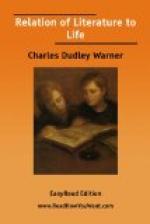Innumerable were the devices of the builders to keep their inventions afloat. Some paid great attention to the form of the hull, others to the kind of cargo and the loading of it, while others—and these seemed the majority—trusted more to some new sort of sail, or new fashion of rudder, or new application of propelling power. And it was wonderful to see what these new ingenuities did for a time, and how each generation was deceived into the belief that its products would sail on forever. But one fate practically came to the most of them. They were too heavy, they were too light, they were built of old material, and they went to the bottom, they went ashore, they broke up and floated in fragments. And especially did the crafts built in imitation of something that had floated down from a previous generation come to quick disaster. I saw only here and there a vessel, beaten by weather and blackened by time —so old, perhaps, that the name of the maker was no longer legible; or some fragments of antique wood that had evidently come from far up the stream. When such a vessel appeared there was sure to arise great dispute about it, and from time to time expeditions were organized to ascend the river and discover the place and circumstances of its origin. Along the banks, at intervals, whole fleets of boats and fragments had gone ashore, and were piled up in bays, like the driftwood of a subsided freshet. Efforts were made to dislodge these from time to time and set them afloat again, newly christened, with fresh paint and sails, as if they stood a better chance of the voyage than any new ones. Indeed, I saw that a large part of the commerce of this river was, in fact, the old hulks and stranded wrecks that each generation had set afloat again. As I saw it in this foolish vision, how pathetic this labor was from generation to generation; so many vessels launched; so few making a voyage even for a lifetime; so many builders confident of immortality; so many lives outlasting this coveted reputation! And still the generations, each with touching hopefulness, busied themselves with this child’s play on the banks of the stream; and still the river flowed on, whelming and wrecking the most of that so confidently committed to it, and bearing only here and there, on its swift, wide tide, a ship, a boat, a shingle.
These hosts of men whom I saw thus occupied since history began were authors; these vessels were books; these heaps of refuse in the bays were great libraries. The allegory admits of any amount of ingenious parallelism. It is nevertheless misleading; it is the illusion of an idle fancy. I have introduced it because it expresses, with some whimsical exaggeration—not much more than that of “The Vision of Mirza”—the popular notion about literature and its relation to human life. In the popular conception, literature is as much a thing apart from life as these boats on the stream of time were from the existence, the struggle, the decay of the generations along the shore.




